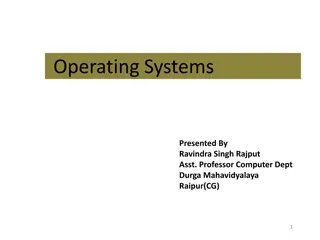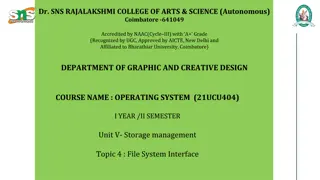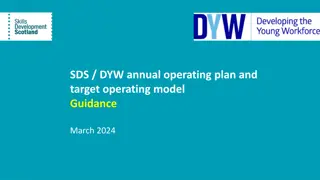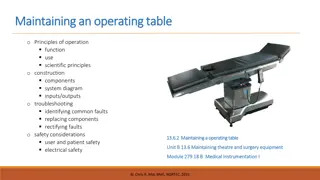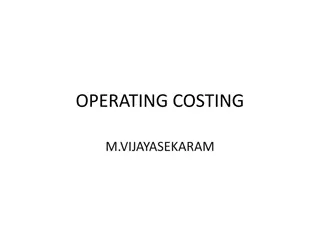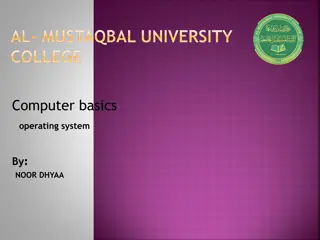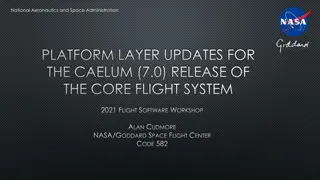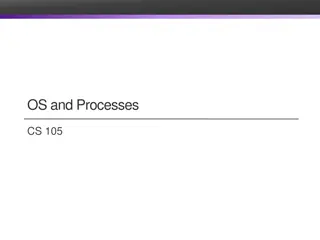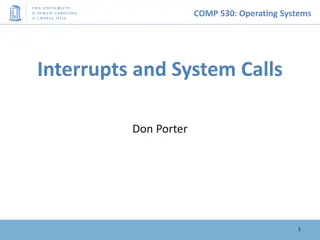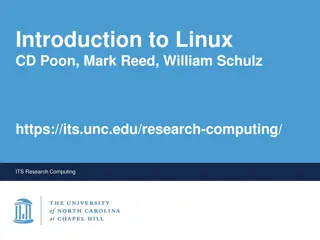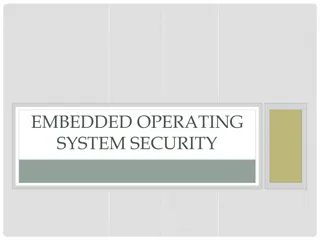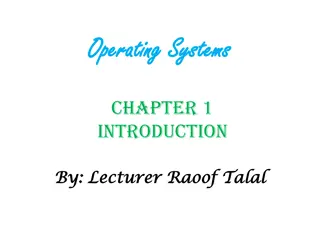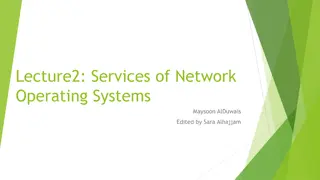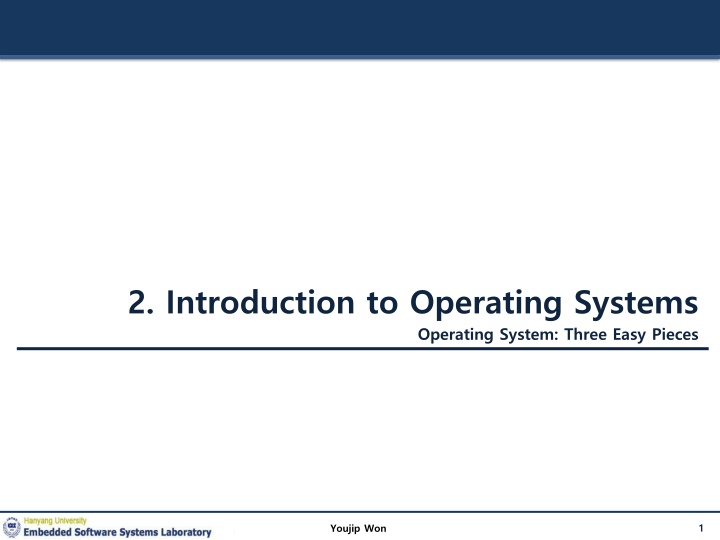
Operating Systems: A Beginner's Guide
Dive into the fundamentals of operating systems with this beginner-friendly overview. Learn about program execution, the role of the operating system in managing resources, virtualization, system calls, and more. Explore how the OS facilitates program running, memory sharing, device interaction, and efficient system operations.
Uploaded on | 2 Views
Download Presentation

Please find below an Image/Link to download the presentation.
The content on the website is provided AS IS for your information and personal use only. It may not be sold, licensed, or shared on other websites without obtaining consent from the author. If you encounter any issues during the download, it is possible that the publisher has removed the file from their server.
You are allowed to download the files provided on this website for personal or commercial use, subject to the condition that they are used lawfully. All files are the property of their respective owners.
The content on the website is provided AS IS for your information and personal use only. It may not be sold, licensed, or shared on other websites without obtaining consent from the author.
E N D
Presentation Transcript
2. Introduction to Operating Systems Operating System: Three Easy Pieces 1 Youjip Won
What a happens when a program runs? A running program executes instructions. 1. The processor fetches an instruction from memory. 2. Decode: Figure out which instruction this is 3. Execute: i.e., add two numbers, access memory, check a condition, jump to function, and so forth. 4. The processor moves on to the next instruction and so on. 2 Youjip Won
Operating System (OS) Responsible for Making it easy to run programs Allowing programs to share memory Enabling programs to interact with devices OS is in charge of making sure the system operates correctly and efficiently. 3 Youjip Won
Virtualization The OS takes a physical resource and transforms it into a virtual form of itself. Physical resource: Processor, Memory, Disk The virtual form is more general, powerful and easy-to-use. Sometimes, we refer to the OS as a virtual machine. 4 Youjip Won
System call System call allows user to tell the OS what to do. The OS provides some interface (APIs, standard library). A typical OS exports a few hundred system calls. Run programs Access memory Access devices 5 Youjip Won
The OS is a resource manager. The OS manage resources such as CPU, memory and disk. The OS allows Many programs to run Sharing the CPU Many programs to concurrently access their own instructions and data Sharing memory Many programs to access devices Sharing disks 6 Youjip Won
Virtualizing the CPU The system has a very large number of virtual CPUs. Turning a single CPU into a seemingly infinite number of CPUs. Allowing many programs to seemingly run at once Virtualizing the CPU 7 Youjip Won
Virtualizing the CPU (Cont.) 1 2 3 4 5 6 7 8 9 10 11 12 13 14 15 16 #include <stdio.h> #include <stdlib.h> #include <sys/time.h> #include <assert.h> #include "common.h" int main(int argc, char *argv[]) { if (argc != 2) { fprintf(stderr, "usage: cpu <string>\n"); exit(1); } char *str = argv[1]; while (1) { Spin(1); // Repeatedly checks the time and returns once it has run for a second printf("%s\n", str); } return 0; 17 18 19 20 } Simple Example(cpu.c): Code That Loops and Prints 8 Youjip Won
Virtualizing the CPU (Cont.) Execution result 1. prompt> gcc -o cpu cpu.c -Wall prompt> ./cpu "A" A A A C prompt> Run forever; Only by pressing Control-c can we halt the program 9 Youjip Won
Virtualizing the CPU (Cont.) Execution result 2. prompt> ./cpu A & ; ./cpu B & ; ./cpu C & ; ./cpu D & [1] 7353 [2] 7354 [3] 7355 [4] 7356 A B D C A B D C A C B D ... Even though we have only one processor, all four of programs seem to be running at the same time! 10 Youjip Won
Virtualizing Memory The physical memory is an array of bytes. A program keeps all of its data structures in memory. Read memory (load): Specify an address to be able to access the data Write memory (store): Specify the data to be written to the given address 11 Youjip Won
Virtualizing Memory (Cont.) A program that Accesses Memory (mem.c) 1 2 3 4 5 6 7 8 9 #include <unistd.h> #include <stdio.h> #include <stdlib.h> #include "common.h" int main(int argc, char *argv[]) { int *p = malloc(sizeof(int)); // a1: allocate some memory 10 11 12 assert(p != NULL); printf("(%d) address of p: %08x\n", getpid(), (unsigned) p); // a2: print out the address of the memmory 13 14 15 16 17 18 19 20 *p = 0; // a3: put zero into the first slot of the memory while (1) { Spin(1); *p = *p + 1; printf("(%d) p: %d\n", getpid(), *p); // a4 } return 0; } 12 Youjip Won
Virtualizing Memory (Cont.) The output of the program mem.c prompt> ./mem (2134) memory address of p: 00200000 (2134) p: 1 (2134) p: 2 (2134) p: 3 (2134) p: 4 (2134) p: 5 C The newly allocated memory is at address 00200000. It updates the value and prints out the result. 13 Youjip Won
Virtualizing Memory (Cont.) Running mem.c multiple times prompt> ./mem &; ./mem & [1] 24113 [2] 24114 (24113) memory address of p: 00200000 (24114) memory address of p: 00200000 (24113) p: 1 (24114) p: 1 (24114) p: 2 (24113) p: 2 (24113) p: 3 (24114) p: 3 ... It is as if each running program has its own private memory. Each running program has allocated memory at the same address. Each seems to be updating the value at 00200000 independently. 14 Youjip Won
Virtualizing Memory (Cont.) Each process accesses its own private virtual address space. The OS maps address space onto the physical memory. A memory reference within one running program does not affect the address space of other processes. Physical memory is a shared resource, managed by the OS. 15 Youjip Won
The problem of Concurrency The OS is juggling many things at once, first running one process, then another, and so forth. Modern multi-threaded programs also exhibit the concurrency problem. 16 Youjip Won
Concurrency Example A Multi-threaded Program (thread.c) 1 2 3 4 5 6 7 8 9 10 11 12 13 14 15 16 17 18 19 20 21 22 #include <stdio.h> #include <stdlib.h> #include "common.h" volatile int counter = 0; int loops; void *worker(void *arg) { int i; for (i = 0; i < loops; i++) { counter++; } return NULL; } int main(int argc, char *argv[]) { if (argc != 2) { fprintf(stderr, "usage: threads <value>\n"); exit(1); } 17 Youjip Won
Concurrency Example A Multi-threaded Program (thread.c) 1 2 3 4 5 6 7 8 9 10 11 12 13 14 } 15 ... #include <stdio.h> #include <stdlib.h> #include "common.h" volatile int counter = 0; int loops; void *worker(void *arg) { int i; for (i = 0; i < loops; i++) { counter++; } return NULL; 18 Youjip Won
Concurrency Example (Cont.) 16 17 18 19 20 21 22 23 24 25 26 27 28 29 30 31 32 33 int main(int argc, char *argv[]) { if (argc != 2) { fprintf(stderr, "usage: threads <value>\n"); exit(1); } loops = atoi(argv[1]); pthread_t p1, p2; printf("Initial value : %d\n", counter); Pthread_create(&p1, NULL, worker, NULL); Pthread_create(&p2, NULL, worker, NULL); Pthread_join(p1, NULL); Pthread_join(p2, NULL); printf("Final value : %d\n", counter); return 0; } The main program creates two threads. Thread: a function running within the same memory space. Each thread start running in a routine called worker(). worker(): increments a counter 19 Youjip Won
Concurrency Example (Cont.) loops determines how many times each of the two workers will increment the shared counter in a loop. loops: 1000. prompt> gcc -o thread thread.c -Wall -pthread prompt> ./thread 1000 Initial value : 0 Final value : 2000 loops: 100000. prompt> ./thread 100000 Initial value : 0 Final value : 143012 // huh?? prompt> ./thread 100000 Initial value : 0 Final value : 137298 // what the?? 20 Youjip Won
Why is this happening? Increment a shared counter take three instructions. 1. Load the value of the counter from memory into register. 2. Increment it 3. Store it back into memory These three instructions do not execute atomically. Problem of concurrency happen. 21 Youjip Won
Persistence Devices such as DRAM store values in a volatile. Hardware and software are needed to store data persistently. Hardware: I/O device such as a hard drive, solid-state drives(SSDs) Software: File system manages the disk. File system is responsible for storing any files the user creates. 22 Youjip Won
Persistence (Cont.) Create a file (/tmp/file) that contains the string hello world 1 2 3 4 5 6 7 8 9 10 #include <stdio.h> #include <unistd.h> #include <assert.h> #include <fcntl.h> #include <sys/types.h> int main(int argc, char *argv[]) { int fd = open("/tmp/file", O_WRONLY | O_CREAT | O_TRUNC, S_IRWXU); assert(fd > -1); int rc = write(fd, "hello world\n", 13); assert(rc == 13); close(fd); return 0; } 11 12 13 14 15 16 open(), write(), and close() system calls are routed to the part of OS called the file system, which handles the requests 23 Youjip Won
Persistence (Cont.) What OS does in order to write to disk? Figure out where on disk this new data will reside Issue I/O requests to the underlying storage device File system handles system crashes during write. Journaling or copy-on-write Carefully ordering writes to disk 24 Youjip Won
Design Goals Build up abstraction Make the system convenient and easy to use. Provide high performance Minimize the overhead of the OS. OS must strive to provide virtualization without excessive overhead. Protection between applications Isolation: Bad behavior of one does not harm other and the OS itself. 25 Youjip Won
Design Goals (Cont.) High degree of reliability The OS must also run non-stop. Other issues Energy-efficiency Security Mobility 26 Youjip Won
Disclaimer: This lecture slide set was initially developed for Operating System course in Computer Science Dept. at Hanyang University. This lecture slide set is for OSTEP book written by Remzi and Andrea at University of Wisconsin. 27 Youjip Won


